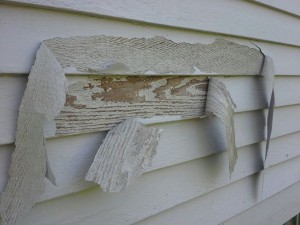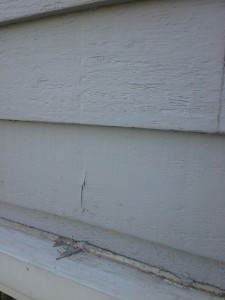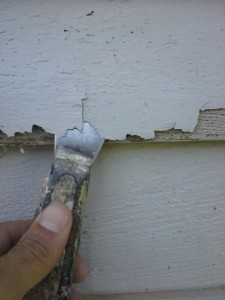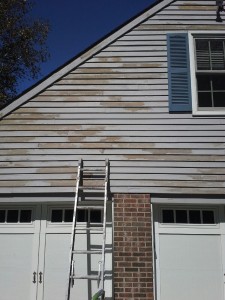Solid color stain is not supposed to peel (like paint does) when applied to cedar siding. The unfortunate reality is that peeling solid color stain is a common occurrence. Many factors can contribute to this problem.
First, many house painting contractors promote the use of a two-coat paint job as offering greater value than a one-coat job. The homeowner assumes that two coats ought to be better than one. However, unless a second coat is needed to ensure good coverage (because of a change in color or a very worn original coat), a second coat only adds thickness to the coating. In the long-term, those multiple coats of stain cause the stain to behave like paint and peel. Generally, homeowners should resist the temptation to accept the second coat of stain, at least without asking the reason for that recommendation.
Other factors can also contribute to the peeling stain problem. Failing to kill mildew spores in the cleaning process can cause the last coat to delaminate from the previous coat. Power washing alone does not kill the spores – a diluted bleach solution does! Staining or painting over mildew spores gives them darkness, which helps them to propagate under the last coat and cause coating failure.
Another insidious cause of solid stain failure on cedar has to do with dead wood fiber on the face of the siding. When the peeling stain is scraped off, dead wood fiber often stays stuck to the back of the flake. This is a telling sign of the problem. No stain, or paint can adhere to dead wood fiber, leading to major coating failure. When this condition exists, we have noticed that the sun accelerates the demise of the coating, by causing countless hot/cold cycles (even many times a day). If a tree shades a portion of the house, that portion may not exhibit the problem, or very little. The North side of the house may also show little sign of delamination as well.
We are often asked what may have caused the dead wood fiber in the first place. We have two main theories. One is that the siding may have sat unfinished for too long after it was installed on the house. The other has to do with moisture. We have noticed that the siding in problem houses is almost never back-primed, which causes the moisture to penetrate into the wood and migrate towards the exterior of the siding. The hot-cold cycles degrade the wood behind the coating and cause the stain or coating to fail. A failed or poorly performing vapor barrier may also aggravate the problem, by allowing more moisture to penetrate into the siding.
The bad news is that there is no easy or inexpensive way to deal with the problem. Extensive scraping and sanding is needed. We also cannot guarantee that the problem will not reoccur. In fact, the stain or paint that will not come off at this time will likely come off later. The best outcome you can hope for is to eventually get ahead of the problem. Unfortunately, the most permanent solution is to remove the siding, install a new vapor barrier and prime the new siding on all sides before its installation.
As house painting contractors in the Chicago area, we have a passion to get to the root cause of the problems we encounter, so that we can devise the best possible solutions and create the most value for our clients.











 Follow
Follow
